
Vestre Slidre is a municipality in Innlandet county, Norway. It is part of the traditional region of Valdres. The administrative centre of the municipality is the village of Slidre. The old municipality of Slidre was divided into Vestre Slidre and Øystre Slidre in 1849.
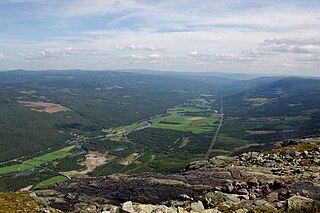
Hemsedal is a municipality in Buskerud county, Norway. It is part of the traditional region of Hallingdal. The administrative centre of the municipality is the village of Trøym. Hemsedal lies on the Norwegian National Road 52. Hemsedal is located 220 km (136.70 mi) northwest of Oslo and 273 km (169.63 mi) from Bergen. In 1897, Hemsedal was separated from the municipality of Gol to become a municipality of its own.

Vik is a municipality in Vestland county, Norway. It is located on the southern shore of the Sognefjorden in the traditional district of Sogn. The administrative center of Vik is the village of Vikøyri. Other villages in the municipality include Feios, Fresvik, Nese, and Vangsnes.

Balestrand is a former municipality in Sogn og Fjordane county, Norway. It was located on the northern shore of the Sognefjorden in the traditional district of Sogn. The administrative center was the village of Balestrand. Other villages in the municipality included Ese, Kvamme, Låne, Sæle, Tjugum, and Vetlefjorden.

Sogndal is a municipality in Vestland county, Norway. It is located on the northern shore of the Sognefjorden in the traditional district of Sogn. The village of Sogndalsfjøra is the administrative center of Sogndal municipality. Other villages include Kaupanger, Kjørnes, Fimreite, Nornes, and Fjærland. Sogndal Airport, Haukåsen is located 10 kilometres (6.2 mi) southwest of Kaupanger.

Aurland is a municipality in the county of Vestland, Norway. It is located on the south side of the Sognefjorden in the traditional district of Sogn. The administrative center is the village of Aurlandsvangen. Other villages include Bakka, Flåm, Undredal, and Gudvangen.

Luster is a municipality in Vestland county, Norway. It is located at the end of the Sognefjorden in the traditional district of Sogn. The administrative centre is the village of Gaupne. Other villages in Luster include Fortun, Hafslo, Indre Hafslo, Jostedal, Luster, Nes, Ornes, Skjolden, Solvorn, and Veitastrond.

Gaular is a former municipality in Sogn og Fjordane county, Norway. It was located in the traditional district of Sunnfjord. The administrative centre was the village of Sande. Other villages in the municipality included Bygstad, Hestad, and Vik. Gaular was sometimes referred to as Fosselandet because it was home to 28 large and small waterfalls. The municipality was centered on the river Gaula. The Viksdalen valley was located in Gaular.

Førde is a former municipality in the county of Sogn og Fjordane, Norway. It was located in the traditional district of Sunnfjord. The administrative center was the town of Førde which in 2016 had 10,255 inhabitants. Other villages in Førde municipality included Bruland, Holsen, Moskog, and Haukedalen. The Øyrane area in the town of Førde was a large industrial/commercial area for the region. The European Route E39 highway passed through the municipality, and it passed by the lake Holsavatnet.

Stryn is a municipality in the county of Vestland, Norway. It is located in the traditional district of Nordfjord. The administrative center of the municipality is the village of Stryn. The municipality is located along the innermost part of the Nordfjorden. Some of the main villages in Stryn include Loen, Innvik, Utvik, Randabygda, Olden, and Flo.
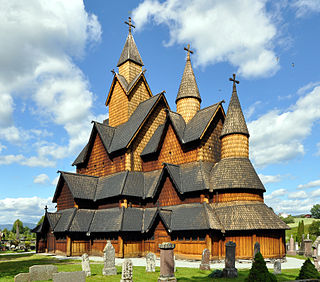
A stave church is a medieval wooden Christian church building once common in north-western Europe. The name derives from the building's structure of post and lintel construction, a type of timber framing where the load-bearing ore-pine posts are called stafr in Old Norse. Two related church building types also named for their structural elements, the post church and palisade church, are often called 'stave churches'.

Lom is a municipality in Innlandet county, Norway. It is part of the traditional region of Gudbrandsdal. The administrative centre of the municipality is the village of Fossbergom. The municipality of Lom was established on 1 January 1838. The area of Skjåk was separated from Lom to become a municipality of its own in 1866.

Borgund Stave Church is a stave church located in the village of Borgund in the municipality of Lærdal in Vestland county, Norway. It is classified as a triple nave stave church of the Sogn-type. The church is part of the Borgund parish in the Sogn prosti (deanery) in the Diocese of Bjørgvin. No longer regularly used for church functions, it is now a museum run by the Society for the Preservation of Ancient Norwegian Monuments.
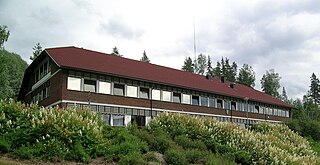
Lampeland is a village located in Buskerud, Norway. It is the administrative centre of Flesberg municipality. The population of the village as of 2013 was 521 residents.

Røldal is a village in the municipality of Odda in Hordaland county, Norway. The village lies in the Røldal valley along the Storelva river on the north end of the lake Røldalsvatnet. Røldal is located about 35 kilometres (22 mi) southeast of the town of Odda. Røldal was formerly part of the independent municipality of Røldal from 1838 until 1964 when it became a part of Odda municipality. The 13th-century Røldal Stave Church is located here.
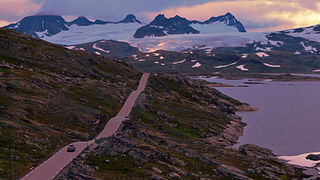
The Sognefjellsvegen or Sognefjellsveien is the highest mountain pass road in Northern Europe. Part of County Road 55, it is located in Innlandet and Vestland counties in Norway. It is a national tourist road and starts in the village of Lom in the municipality of Lom, it then travels over the Sognefjell mountain area, and it ends in the village of Gaupne in the municipality of Luster. The road was opened on 16 July 1938. The road passes through the Jotunheimen, Hurrungane, and Breheimen mountains. The highest point is Fantesteinen at 1,434 metres (4,705 ft). During the winters there is a lot of snow, and so the road is closed from November through May. The road passes between Jotunheimen National Park and Breheimen National Park.

Turtagrø is a hotel in the municipality of Luster in Sogn og Fjordane county, Norway, near Hurrungane in Jotunheimen. The hotel has been a central meeting place for mountaineers from the late 1800s.
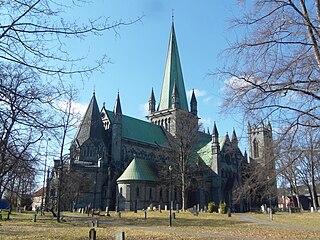
Church building in Norway began when Christianity was established there around the year 1000. The first buildings may have been post churches erected in the 10th or 11th century, but the evidence is inconclusive. For instance under Urnes Stave Church and Lom Stave Church there are traces of older post churches. Post churches were later replaced by the more durable stave churches. About 1,300 churches were built during the 12th and 13th centuries in what was Norway's first building boom. A total of about 3,000 churches have been built in Norway, although nearly half of them have perished. From 1620 systematic records and accounts were kept although sources prior to 1620 are fragmented. Evidence about early and medieval churches is partly archaeological. The "long church" is the most common type of church in Norway. There are about 1620 buildings recognized as churches affiliated with the Church of Norway. In addition, there are a number of gospel halls belonging to the lay movement affiliated with the Church of Norway as well as churches belonging to other Christian bodies. Until the 20th century, most churches were built from wood. 220 buildings are protected by law, and an additional 765 are listed as valuable cultural heritage.
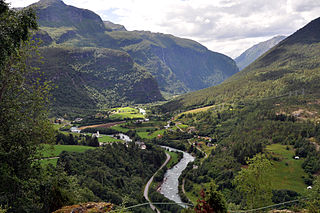
Fortun is a village in Luster Municipality in Vestland county, Norway. The village is located in the Fortundalen valley, just east of Skjolden, at the innermost part of the Lustrafjorden. The Sognefjellsvegen road passes through the village. Fortun is an old church site, having a stave church on the site since the 12th century. The present Fortun Church was built in 1879 in the village, and it serves the eastern part of the municipality. The Hurrungane mountains lie just to the south of the village. The area is known for its scenery and attracts many tourists.
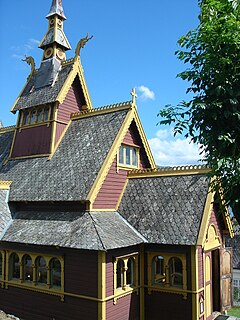
St. Olaf's Church is an Anglican church in the village of Balestrand in Sogndal Municipality in the county of Vestland in Norway. The church was built in 1897 as a stave church imitation and has 95 seats.




















